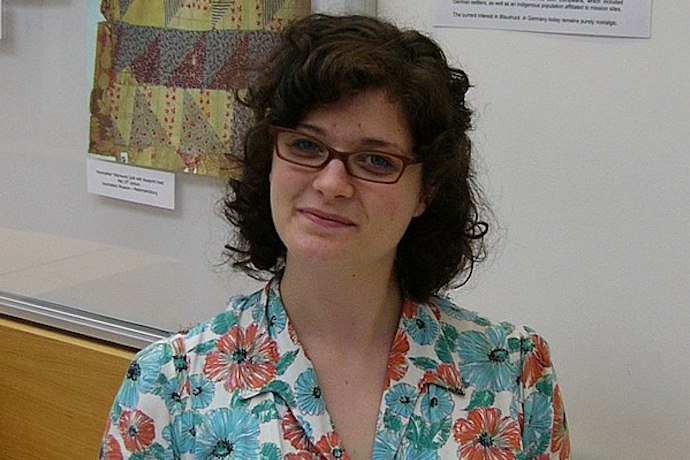
The artist Serena Korda. Photo: CQualmann
Camden Arts Centre, London
By Tom Stewart
British artist Serena Korda’s work ranges from a giant latex tyrannosaurus to, in this case, a bold menagerie of large ceramic jugs. Described as ‘an unfolding sonic experiment that evolves with each set of singers’, The Jug Choir: Ectoplasmic Variations invites members of the public to sing into, over and around the jugs with the intention of exploring their possibilities as instruments.
The ceramics respond to the 16th-century Bellarmine tradition of vessels topped with the image of a bearded Neptune. Korda’s intricate versions break, bulge and crack. Covered with a variety of green, white and purple embellishments, they seem to sprout humorously with every variety of brassica, from delicate heads of cauliflower to the tangled fractals of Romanesco broccoli. They are visually arresting, and their more surprising textural features make you want to see what else Korda can do.
The performance was less engaging. ‘Ectoplasm’ is supposedly supernatural energy focused into a physical medium, but I’m not sure how the idea fitted in here, since there was nothing particularly supernatural or energetic going on. Some of the performers seemed as bemused as me and one or two of their giggles went unstifled.
The piece was supposed to be a meditation on breathing and the body, but for that to work in such a short space of time would have required a far less self-conscious approach. What started out as a dense, seven-part chord of apparently random pitches seemed for the most part to stay that way. Occasionally, short repeated breaths or clicks emerged from the gloom but, since nothing was ever made of them, they sounded directionless and distracting. The same was true of the triangle and cabasa, instruments which seemed to intrude more than complement the music and just didn’t really make sense.
The sound was heavily distorted to the extent that it was impossible to tell whether the ceramics lent anything to the sonorities at all. The positioning of the microphones between the performers’ mouths and the jugs didn’t help, and rendered the occasional word incomprehensible. All this was a shame, since it distracted from Korda’s ceramics, which would have benefitted from a less pretentious musical accompaniment or, better still, no accompaniment at all. ![]()
As someone who took part in Serena’s jug choir, I have to disagree with your review! Rehearsing was hard work, understanding the concept of the breathing mechanism and sounds we had to produce was not actually random but completely and utterly practiced to oblivion at the helm of Serena’s thorough research. Looking back at historical, pagan poetry, sayings and music, the composition is continuously adapted to the group of performers Serena works with, which is testament to her talent! I had an amazing time being part of the choir, it was difficult, fun, challenging and thought-provoking all at the same time! The jugs themselves are indeed gorgeous, but the performers are just individuals in the general public who look to use art and performance as a way of not only assisting the artist, but as expression for themselves.